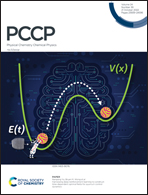Tetra (C60) lanthanum phthalocyanine: design, synthesis and investigation of the third-order nonlinear optical properties†
Abstract
The construction of molecules with effective photoinduced intramolecular electron transfer (PET) and energy transfer (ET) processes is critical for the enhancement of the nonlinear optical (NLO) properties. A novel D–π–A type compound, namely tetra (C60)–LaPc, has been constructed from a molecular design perspective, wherein tetra-formyl phthalocyanine is used as a donor, four C60 as acceptors and the phenylacetylene group is introduced into it as π-electron bridge, which can increase the molecular conjugation, reduce the spatial site resistance and expand the coplanarity of the molecule, thus making the intramolecular charge transfer easier. Tetra (C60)–LaPc achieves excellent NLO properties with a giant nonlinear absorption coefficient (45 cm GW−1 and large third-order susceptibility (4.05 × 10−10 esu), which are superior to those of LaPc and C60. In addition to exhibiting a superior nonlinear optical response at 532 nm compared to the single component, tetra (C60)–LaPc also broadens the limiting range to the near-infrared region, showing a significant enhancement of the optical nonlinearity at 1064 nm. This can be attributed to the synergistic effect of the different non–linear absorption mechanisms between C60 and LaPc and the efficient PET process.



 Please wait while we load your content...
Please wait while we load your content...